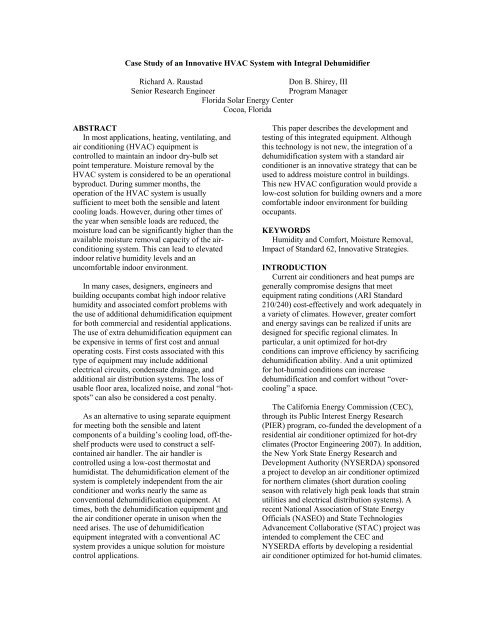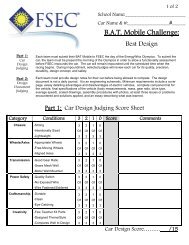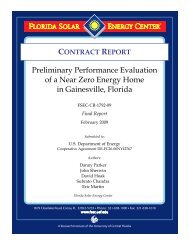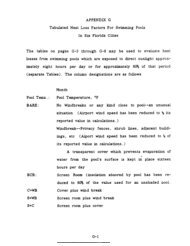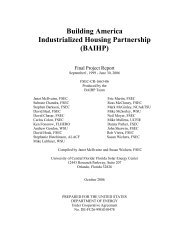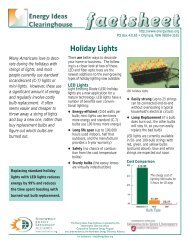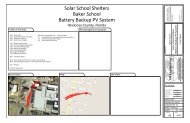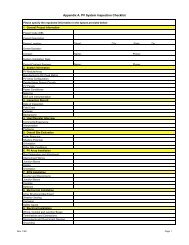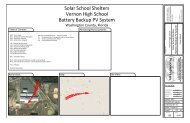Case Study of an Innovative HVAC System with Integral Dehumidifier
Case Study of an Innovative HVAC System with Integral Dehumidifier
Case Study of an Innovative HVAC System with Integral Dehumidifier
Create successful ePaper yourself
Turn your PDF publications into a flip-book with our unique Google optimized e-Paper software.
<strong>Case</strong> <strong>Study</strong> <strong>of</strong> <strong>an</strong> <strong>Innovative</strong> <strong>HVAC</strong> <strong>System</strong> <strong>with</strong> <strong>Integral</strong> <strong>Dehumidifier</strong><br />
Richard A. Raustad Don B. Shirey, III<br />
Senior Research Engineer Program M<strong>an</strong>ager<br />
Florida Solar Energy Center<br />
Cocoa, Florida<br />
ABSTRACT<br />
In most applications, heating, ventilating, <strong>an</strong>d<br />
air conditioning (<strong>HVAC</strong>) equipment is<br />
controlled to maintain <strong>an</strong> indoor dry-bulb set<br />
point temperature. Moisture removal by the<br />
<strong>HVAC</strong> system is considered to be <strong>an</strong> operational<br />
byproduct. During summer months, the<br />
operation <strong>of</strong> the <strong>HVAC</strong> system is usually<br />
sufficient to meet both the sensible <strong>an</strong>d latent<br />
cooling loads. However, during other times <strong>of</strong><br />
the year when sensible loads are reduced, the<br />
moisture load c<strong>an</strong> be signific<strong>an</strong>tly higher th<strong>an</strong> the<br />
available moisture removal capacity <strong>of</strong> the airconditioning<br />
system. This c<strong>an</strong> lead to elevated<br />
indoor relative humidity levels <strong>an</strong>d <strong>an</strong><br />
uncomfortable indoor environment.<br />
In m<strong>an</strong>y cases, designers, engineers <strong>an</strong>d<br />
building occup<strong>an</strong>ts combat high indoor relative<br />
humidity <strong>an</strong>d associated comfort problems <strong>with</strong><br />
the use <strong>of</strong> additional dehumidification equipment<br />
for both commercial <strong>an</strong>d residential applications.<br />
The use <strong>of</strong> extra dehumidification equipment c<strong>an</strong><br />
be expensive in terms <strong>of</strong> first cost <strong>an</strong>d <strong>an</strong>nual<br />
operating costs. First costs associated <strong>with</strong> this<br />
type <strong>of</strong> equipment may include additional<br />
electrical circuits, condensate drainage, <strong>an</strong>d<br />
additional air distribution systems. The loss <strong>of</strong><br />
usable floor area, localized noise, <strong>an</strong>d zonal “hotspots”<br />
c<strong>an</strong> also be considered a cost penalty.<br />
As <strong>an</strong> alternative to using separate equipment<br />
for meeting both the sensible <strong>an</strong>d latent<br />
components <strong>of</strong> a building’s cooling load, <strong>of</strong>f-theshelf<br />
products were used to construct a selfcontained<br />
air h<strong>an</strong>dler. The air h<strong>an</strong>dler is<br />
controlled using a low-cost thermostat <strong>an</strong>d<br />
humidistat. The dehumidification element <strong>of</strong> the<br />
system is completely independent from the air<br />
conditioner <strong>an</strong>d works nearly the same as<br />
conventional dehumidification equipment. At<br />
times, both the dehumidification equipment <strong>an</strong>d<br />
the air conditioner operate in unison when the<br />
need arises. The use <strong>of</strong> dehumidification<br />
equipment integrated <strong>with</strong> a conventional AC<br />
system provides a unique solution for moisture<br />
control applications.<br />
This paper describes the development <strong>an</strong>d<br />
testing <strong>of</strong> this integrated equipment. Although<br />
this technology is not new, the integration <strong>of</strong> a<br />
dehumidification system <strong>with</strong> a st<strong>an</strong>dard air<br />
conditioner is <strong>an</strong> innovative strategy that c<strong>an</strong> be<br />
used to address moisture control in buildings.<br />
This new <strong>HVAC</strong> configuration would provide a<br />
low-cost solution for building owners <strong>an</strong>d a more<br />
comfortable indoor environment for building<br />
occup<strong>an</strong>ts.<br />
KEYWORDS<br />
Humidity <strong>an</strong>d Comfort, Moisture Removal,<br />
Impact <strong>of</strong> St<strong>an</strong>dard 62, <strong>Innovative</strong> Strategies.<br />
INTRODUCTION<br />
Current air conditioners <strong>an</strong>d heat pumps are<br />
generally compromise designs that meet<br />
equipment rating conditions (ARI St<strong>an</strong>dard<br />
210/240) cost-effectively <strong>an</strong>d work adequately in<br />
a variety <strong>of</strong> climates. However, greater comfort<br />
<strong>an</strong>d energy savings c<strong>an</strong> be realized if units are<br />
designed for specific regional climates. In<br />
particular, a unit optimized for hot-dry<br />
conditions c<strong>an</strong> improve efficiency by sacrificing<br />
dehumidification ability. And a unit optimized<br />
for hot-humid conditions c<strong>an</strong> increase<br />
dehumidification <strong>an</strong>d comfort <strong>with</strong>out “overcooling”<br />
a space.<br />
The California Energy Commission (CEC),<br />
through its Public Interest Energy Research<br />
(PIER) program, co-funded the development <strong>of</strong> a<br />
residential air conditioner optimized for hot-dry<br />
climates (Proctor Engineering 2007). In addition,<br />
the New York State Energy Research <strong>an</strong>d<br />
Development Authority (NYSERDA) sponsored<br />
a project to develop <strong>an</strong> air conditioner optimized<br />
for northern climates (short duration cooling<br />
season <strong>with</strong> relatively high peak loads that strain<br />
utilities <strong>an</strong>d electrical distribution systems). A<br />
recent National Association <strong>of</strong> State Energy<br />
Officials (NASEO) <strong>an</strong>d State Technologies<br />
Adv<strong>an</strong>cement Collaborative (STAC) project was<br />
intended to complement the CEC <strong>an</strong>d<br />
NYSERDA efforts by developing a residential<br />
air conditioner optimized for hot-humid climates.


